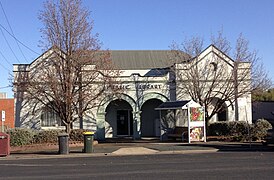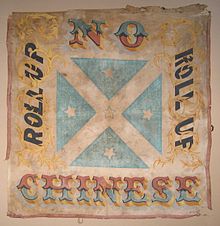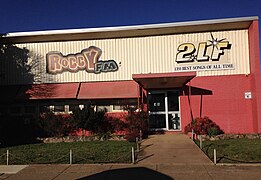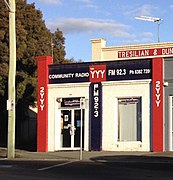
Mudgee is a town in the Central West of New South Wales, Australia. It is in the broad fertile Cudgegong River valley 261 km (162 mi) north-west of Sydney and is the largest town in the Mid-Western Regional Council local government area as well as being the council seat. At the 2021 Census, its population was 11,457. The district lies across the edge of the geological structure known as the Sydney Basin.

Forbes is a town in the Central West region of New South Wales, Australia, located on the Newell Highway between Parkes and West Wyalong. At the 2021 census, Forbes had a population of 9,319. Forbes is probably named after Sir Francis Forbes, first Chief Justice of NSW.

Cowra is a small town in the Central West region of New South Wales, Australia. It is the largest population centre and the council seat for the Cowra Shire, with a population of 9,863.
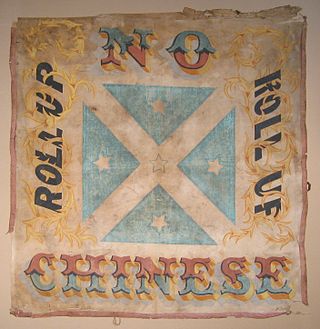
The Lambing Flat riots were a series of violent anti-Chinese demonstrations that took place in the Burrangong region, in New South Wales, Australia. They occurred on the goldfields at Spring Creek, Stoney Creek, Back Creek, Wombat, Blackguard Gully, Tipperary Gully, and Lambing Flat.

Cootamundra, nicknamed Coota, is a town in the South West Slopes region of New South Wales, Australia and within the Riverina. It is within the Cootamundra-Gundagai Regional Council. At the 2016 Census, Cootamundra had a population of 6,782. It is located on the Olympic Highway at the point where it crosses the Muttama Creek, between Junee and Cowra. Its railway station is on the Main Southern line, part of the Melbourne-to-Sydney line.

Captains Flat is a town in the Southern Tablelands of rural New South Wales, Australia, in Queanbeyan-Palerang Regional Council. It is south of Queanbeyan. Captains Flat township is bounded by the non-urban parts of the locality of Captains Flat in the north, east and west, and Captains Flat Road, the Molonglo River and Foxlow Street in the south.

Grenfell is a town in Weddin Shire in the Central West of New South Wales, Australia. It is 370 km (230 mi) west of Sydney. It is close to Forbes, Cowra and Young. At the 2011 census, Grenfell had a population of 1,996. The town is served daily by connecting NSW TrainLink services from Sydney via Bathurst and Lithgow. Grenfell is approximately 5 hours from Sydney and 2+1⁄2 hours from Canberra.
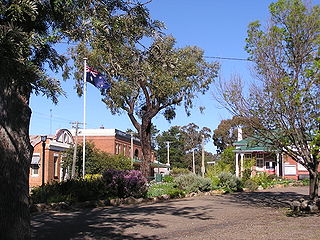
Binalong is a village in the Southern Tablelands of New South Wales, Australia, 37 km north-west of Yass in Yass Valley Shire. At the 2016 census, Binalong and the surrounding area had a population of 543.

Murringo is a small village in the southwestern slopes of New South Wales, Australia in Hilltops Council. It was once better known as Marengo. The name is also applied to the surrounding area, for postal and statistical purposes.

Woodstock is a village in the central west of New South Wales, Australia, 21 kilometres (13 mi) north east of Cowra. It contains remains of a brief goldrush during the late 19th century which left behind a number of substantial buildings before the village relapsed into relative isolation. It includes a restored railway station, hotel and a memorial hall. At the 2011 census, Woodstock had a population of 812.

The Central West is a region in central New South Wales, Australia. The region is situated west of Sydney, which stretches from Lithgow in the east and to as far west as Lake Cargelligo, on the Lachlan River. The Central West is known for its attractions such as the Jenolan Caves, near Oberon and also wineries, as well as rural farmland and natural landscapes. The region includes major towns like, Bathurst, Orange, Mudgee, Lithgow, Parkes and Cowra. It has an area of 63,262 square kilometres (24,426 sq mi). The region also includes the sub-region known as the Central Tablelands, located in the eastern part of the region. The region known as the Orana, which includes the area surrounding Dubbo is typically classed as being a part of the Central West also.
Young was an electoral district for the Legislative Assembly in the Australian state of New South Wales, named after and including the town of Young. It elected two members between 1880 and 1894 and one member from 1894 to 1904, when it was replaced by Burrangong. The sitting member George Burgess (Labor) successfully contested Burrangong. In 1920, with the introduction of proportional representation, Burrangong was absorbed by the three member district of Cootamundra. Proportional representation was abandoned in 1927 and Young was recreated. It was abolished in 1981 and the district was split with Young being absorbed by Burrinjuck while the towns of Cowra and Forbes were absorbed by a re-created Lachlan.

Wombat is a town in South West Slopes region of New South Wales, Australia. It is situated on the Olympic Highway, 15 kilometres (9.3 mi) south-west of the regional centre of Young. It is in the local government area of Hilltops Council.
John George Gough, was one of the founders of the New South Wales Labour Party, initially the Labour Electoral League, the first political Labour movement in Australia. He was also one of Labour's five-member leadership group when the party first made its appearance in the New South Wales parliament in 1891. Representing Young, he was first elected in 1889 to the parliament's lower house as a member of the Protectionist Party, which produced Australia's first two prime ministers, Edmund Barton and Alfred Deakin. From 1891 to 1894 he represented Labour. Proud that his mother was Australian-born, he was a strong nationalist and republican. John Gough's maternal grandmother was half-aboriginal. He is the only one of Labor's founding fathers who has been found to have had aboriginal ancestry.

Timor (/ˈtaɪˈmɔː/), short-speak for the adjoining localities of Bowenvale and Timor, in the Central Goldfields Shire of Victoria, Australia. Their shared boundary is 8 kilometres (5 mi) north of Maryborough, Victoria and 178 kilometres (111 mi) northwest of Melbourne, the state capital.
New South Wales experienced the first gold rush in Australia, a period generally accepted to lie between 1851 and 1880. This period in the history of New South Wales resulted in a rapid growth in the population and significant boost to the economy of the colony of New South Wales. The California Gold Rush three years prior signaled the impacts on society that gold fever would produce, both positive and negative. The New South Wales colonial government concealed the early discoveries, but various factors changed the policy.
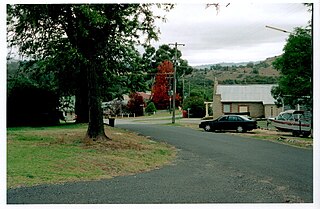
Wyangala is a small village in the Lachlan Valley, near the junction of the Abercrombie and Lachlan Rivers, just below the Wyangala Dam wall. It is in the South West Slopes of New South Wales, Australia, and about 320 km (200 mi) west of the state capital, Sydney. The name is also used for the surrounding rural locality, which includes the site of the former mining village of Mount McDonald.
Margaret Turner Clarke was an Australian nurse and philanthropist. She was a pioneer within nursing in Australia. A student of the Florence Nightingale School for Nurses, she was the founder of the Visiting Relief Society in 1865, and a co-founder of the pioneer nursing education Home and Training School for Nurses in Sydney (1882).

Blackguard Gully is a heritage-listed former Chinese mining camp and now reserve at Whiteman Avenue, Young, Hilltops Council, New South Wales, Australia. It was part of the Lambing Flat or Burragorang goldfields, and was a primary location of the anti-Chinese Lambing Flat riots of 1861. The property is owned by the Hilltops Council. It was added to the New South Wales State Heritage Register on 13 March 2009.
The Burrangong Argus was an Australian newspaper based in Young, New South Wales, published twice-weekly from 1865 to 1913. It was, at the time of its closure, the oldest newspaper in Young. It sold at 6d per copy, then 3d per copy and finally 1d per copy, as it attempted to compete with later rivals the Young Chronicle and Young Witness.





